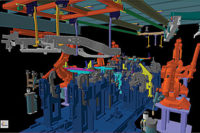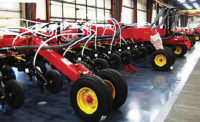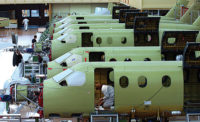All professors are teachers, but some are also entrepreneurs. Three of note are mechanical engineering professors Stephen L. Dickerson, Wayne Book and Nader Sadegh, who together founded CAMotion Inc. in 1997 while working at the Georgia Institute of Technology.
They started CAMotion with a simple goal: develop cost-effective automation equipment for manufacturers so they wouldn’t offshore manufacturing to low-wage countries. The equipment’s key feature was proprietary control-algorithm technology that produced high-speed, accurate motion.
Today the Atlanta-based company specializes in the design and production of sophisticated palletizing machinery, pick-and-place robot systems and advanced crane-control technologies. It serves many manufacturers in the automotive, printing and material-handling industries.
Among the more complex systems CAMotion manufactures are turnkey robotic gantry palletizers designed to automate pallet loading and unloading. The palletizers operate on overhead rails, permitting coverage of very large workspaces and the servicing of multiple pallets with a single robot. They are also scalable and cover a range of payloads and work envelopes.
However, some customers require specialized palletizers. Scott Coleman, chief design engineer for CAMotion, cites one such end-user in the printing industry. The company requires a system with a variable-height bundle sorter, which reorders bundles of varying height magazines into uniform fixed-height stacks.
CAMotion decided to assemble the system frame with Misumi USA HFS Series aluminum structural extrusions rather than welded steel to save time and money. Unfortunately, the system frame was initially designed as a single SolidWorks 3D CAD part, so Coleman had to convert each frame member (more than 90) into a precisely configured structural extrusion. He did this by measuring the length and hole location of each member, and entering this data into Misumi’s online CAD Configurator.
Coleman then downloaded the parts and (visually) laid them over the frame model. They were automatically added to the bill of materials (BOM), which provided line numbers in the precise order in which the parts needed to be assembled. Finally, Coleman exported the BOM to an Excel spreadsheet, from which he cut and pasted all part numbers directly into Misumi’s Web ordering system.
“When the extrusion shipment arrived, each extrusion had the BOM line number on the packaging label,” says Coleman. “This allowed our shop (workers) to lay parts out in numerical order without searching through piles. The frame was assembled in about a day with no missing parts, wasted time or rework.”
When the frame’s mechanical system was complete, electrical wiring and pneumatic plumbing were added. Coleman claims that if the frame had been designed as a steel weldment, shop machinists would have had to drill and tap at least 50 holes to attach cables and air-line anchors. With aluminum extrusions, they just added twist-in cable anchors where needed without any drilling.
Coleman says it took two days for him to complete detailed drawings, the BOM and extrusion purchasing, compared to six for a steel frame. He only waited eight days for delivery of the extrusions, whereas fabrication time for a welded frame would have been at least four weeks.
As for CAMotion’s three founders, they are still teaching at the Georgia Institute of Technology. Dickerson is professor emeritus and Sadegh an associate professor at the institute’s George Woodruff School of Mechanical Engineering. Book is professor emeritus at the Woodruff School’s Intelligent Machine Dynamics Laboratory.
For more information on aluminum extrusions, call 800-681-7475 or visit http://us.misumi-ec.com.





